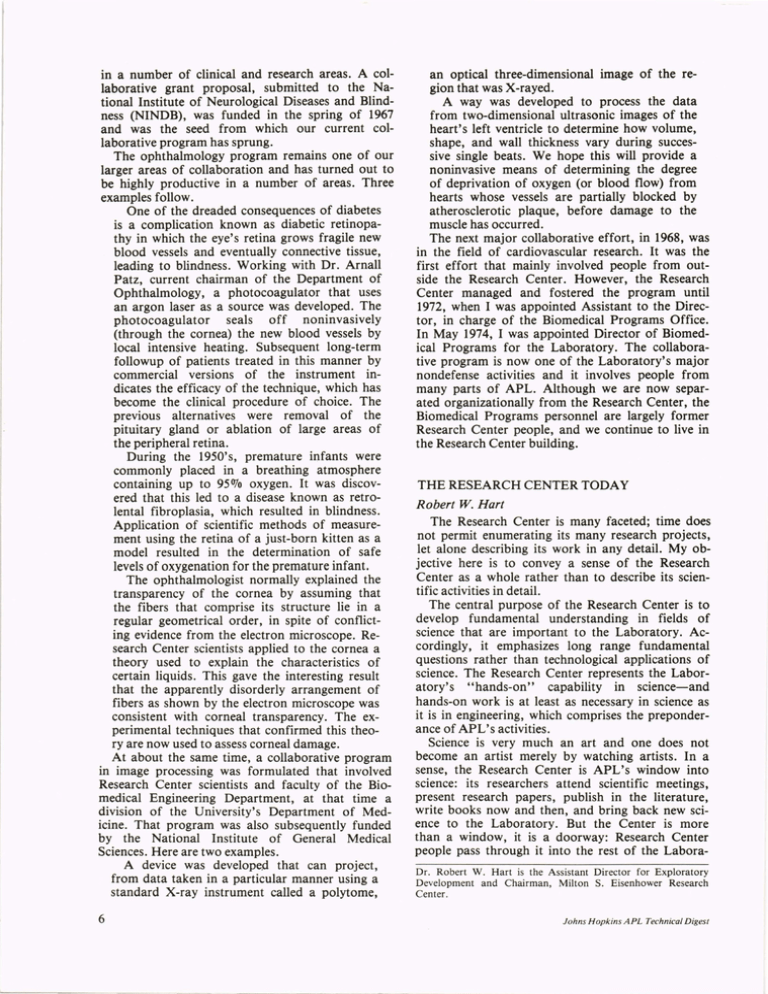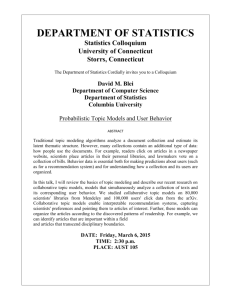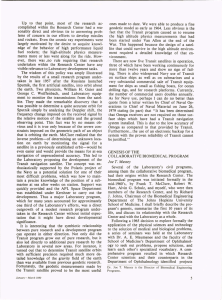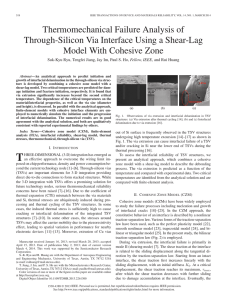in a number of clinical and ... an optical three-dimensional image of ...
advertisement

in a number of clinical and research areas. A collaborative grant proposal, submitted to the National Institute of Neurological Diseases and Blindness (NINDB), was funded in the spring of 1967 and was the seed from which our current collaborative program has sprung. The ophthalmology program remains one of our larger areas of collaboration and has turned out to be highly productive in a number of areas. Three examples follow. One of the dreaded consequences of diabetes is a complication known as diabetic retinopathy in which the eye's retina grows fragile new blood vessels and eventually connective tissue, leading to blindness. Working with Dr. Arnall Patz, current chairman of the Department of Ophthalmology, a photocoagulator that uses an argon laser as a source was developed. The photocoagulator seals off noninvasively (through the cornea) the new blood vessels by local intensive heating. Subsequent long-term followup of patients treated in this manner by commercial versions of the instrument indicates the efficacy of the technique, which has become the clinical procedure of choice. The previous alternatives were removal of the pituitary gland or ablation of large areas of the peripheral retina. During the 1950's, premature infants were commonly placed in a breathing atmosphere containing up to 95070 oxygen. It was discovered that this led to a disease known as retrolental fibroplasia, which resulted in blindness. Application of scientific methods of measurement using the retina of a just-born kitten as a model resulted in the determination of safe levels of oxygenation for the premature infant. The ophthalmologist normally explained the transparency of the cornea by assuming that the fibers that comprise its structure lie in a regular geometrical order, in spite of conflicting evidence from the electron microscope. Research Center scientists applied to the cornea a theory used to explain the characteristics of certain liquids. This gave the interesting result that the apparently disorderly arrangement of fibers as shown by the electron microscope was consistent with corneal transparency. The experimental techniques that confirmed this theory are now used to assess corneal damage. At about the same time, a collaborative program in image processing was formulated that involved Research Center scientists and faculty of the Biomedical Engineering Department, at that time a division of the University's Department of Medicine. That program was also subsequently funded by the National Institute of General Medical Sciences. Here are two examples. A device was developed that can project, from data taken in a particular manner using a standard X-ray instrument called a polytome, 6 an optical three-dimensional image of the region that was X-rayed. A way was developed to process the data from two-dimensional ultrasonic images of the heart's left ventricle to determine how volume, shape, and wall thickness vary during successive single beats. We hope this will provide a noninvasive means of determining the degree of deprivation of oxygen (or blood flow) from hearts whose vessels are partially blocked by atherosclerotic plaque, before damage to the muscle has occurred. The next major collaborative effort, in 1968, was in the field of cardiovascular research. It was the first effort that mainly involved people from outside the Research Center. However, the Research Center managed and fostered the program until 1972, when I was appointed Assistant to the Director, in charge of the Biomedical Programs Office. In May 1974, I was appointed Director of Biomedical Programs for the Laboratory. The collaborative program is now one of the Laboratory's major nondefense activities and it involves people from many parts of APL. Although we are now separated organizationally from the Research Center, the Biomedical Programs personnel are largely former Research Center people, and we continue to live in the Research Center building. THE RESEARCH CENTER TODAY Robert W. Hart The Research Center is many faceted; time does not permit enumerating its many research projects, let alone describing its work in any detail. My objective here is to convey a sense of the Research Center as a whole rather than to describe its scientific activities in detail. The central purpose of the Research Center is to develop fundamental understanding in fields of science that are important to the Laboratory. Accordingly, it emphasizes long range fundamental questions rather than technological applications of science. The Research Center represents the Laboratory's "hands-on" capability in science-and hands-on work is at least as necessary in science as it is in engineering, which comprises the preponderance of APL's activities. Science is very much an art and one does not become an artist merely by watching artists. In a sense, the Research Center is APL's window into science: its researchers attend scientific meetings, present research papers, publish in the literature, write books now and then, and bring back new science to the Laboratory. But the Center is more than a window, it is a doorway: Research Center people pass through it into the rest of the LaboraDr. Robert W. Hart is the Assistant Director for Exploratory Development and Chairman, Milton S. Eisenhower Research Center. Johns Hopkins A PL Technical Digest tory and people from the engineering activities of the Laboratory come into the Research Center to work and to consult. For more than 25 years, the size of the Research Center staff has been stable at about 55 people, including about 40 senior scientists. Because it is not large enough to work in all the fields important to the Laboratory, it must be selective. The selection process is highly complex and individual. It involves choosing fields where the impact of new understanding can be large for APL, for the Navy, for other Department of Defense agencies, and for national concerns about energy, environment, and health. The administrative structure is simple in concept and complex in application. There are eight groups and eight core projects but two dozen or more other projects are funded by such agencies as the National Science Foundation, the National Institutes of Health, the Department of Energy, the Navy, and the Army (see Fig. 7, p. 18). This diversity of effort may seem excessive because a minimum critical mass level of effort is usually needed in an area in order to have a recognizable impact. But there are several reasons why the diversity is effective. One reason is that Research Center scientists work with about an equal number of volunteer collaborators at other institutions in this country and abroad, so that the Research Center is in effect bigger than it might seem. Another reason why the diversity is effective is because the group boundaries are so permeable that researchers in each group also work on projects of other groups. Thus, the research horizon for individual researchers is much broader than the group designations would suggest and the cooperative interactions build necessary critical mass levels of effort. Most important is that the intergroup cooperation is effective in achieving a unifying theme. To sense the significance of this intergroup cooperation, think of the Research Center groups as the individual voices of an orchestra playing the different notes of a composition. The central theme of the composition unifies the diverse voices. The Research Center's present central theme is interfacial science, the science of processes that occur in the neighborhood of and because of surfaces. Surface science is now one of the important and active frontier areas in science. Present day semiconductor technology derived in large part from developing and exploiting understanding of solid-solid interfaces (e.g., the internal junctions of transistors). At solid-gas junctions, ablation, erosion, and chemical reactions of missile surfaces and reentry bodies affect their performance and the ability to predict how they will behave. Solid-liquid junctions are important in corrosion processes, which cost the nation billions of dollars annually and are not well understood. Corrosion prevents taking full ad- January -March 1980 vantage of the hot, corrosive fluids from deep in the earth for geothermal energy use. Solid-liquid interfaces are also important to medical implants. Solid-gas junctions are typical of catalysis and relate to such energy problems as burning coal cleanly and converting it to other products. I have been dwelling on the importance of interfacial science to technology rather than on the scientific aspects of the research because it is easier for the nonscientist to appreciate the significance of work that can be technologically important than to appreciate the science itself-which would be couched in the scientists' jargon, his models, and his frame of thinking. But it is important to convey some feeling for the scientific challenge. To sense this, one must realize that most of a scientist's training has traditionally emphasized homogeneous materials-gases, liquids, solids-rather than the more difficult interfaces between them. These boundaries represent a tremendous challenge to theory, because the theoretician generally does not know a priori where the boundary is, what shape it will be, or others of its essential characteristics. Mathematicians call one class of these problems "Steklov problems" after a Russian scientist who first explored many of their properties. The Applied Mathematics Group of five people has made progress in dealing with these kinds of difficult problems. The Theoretical Physics Group is currently developing new methods for dealing with the interactions of waves with surfaces. Interfacial science is a tremendous challenge also to the experimental scientist because his instrumentation has been unable, until recently, to resolve what happens in the first few atomic layers adjacent to interfaces, where the chemical binding is changed, altering structure and behavior. But in the last dozen years, there have been big advances, both theoretically and experimentally; as a result, interfacial science is burgeoning. The Research Center is stationing itself on this technologically important and scientifically challenging frontier. With respect to the Chemical Physics Group, there is much to be learned about heterogeneous processes when they are approached from the chemists' standpoint. The Solid State Physics Group is developing understanding of polycrystalline solar cells. The Electronic Physics Group has recently discovered a new step in corrosion processes and is extending its well-established gas phase expertise into the domain of reactions at gas-solid surfaces. The Quantum Electronics Group is developing new organic and organometallic materials having unusual electrical, optical, and liquid-solid interfacial properties. The Excitation Mechanisms Group is developing laser techniques for the study of surface-related phenomena. The Microwave Physics Group is beginning to investigate electromagnetic field effects in membranes. 7




